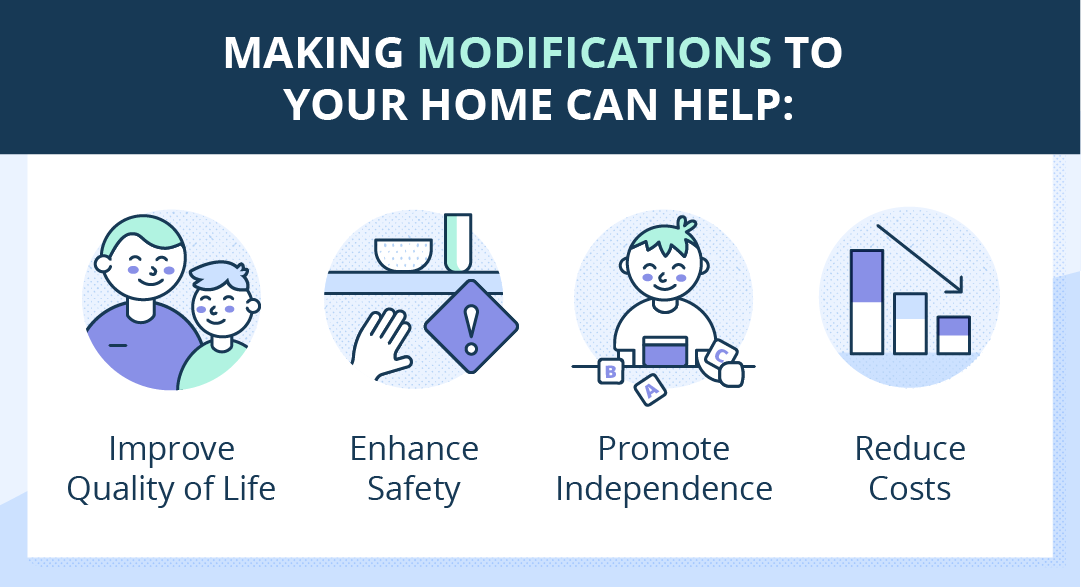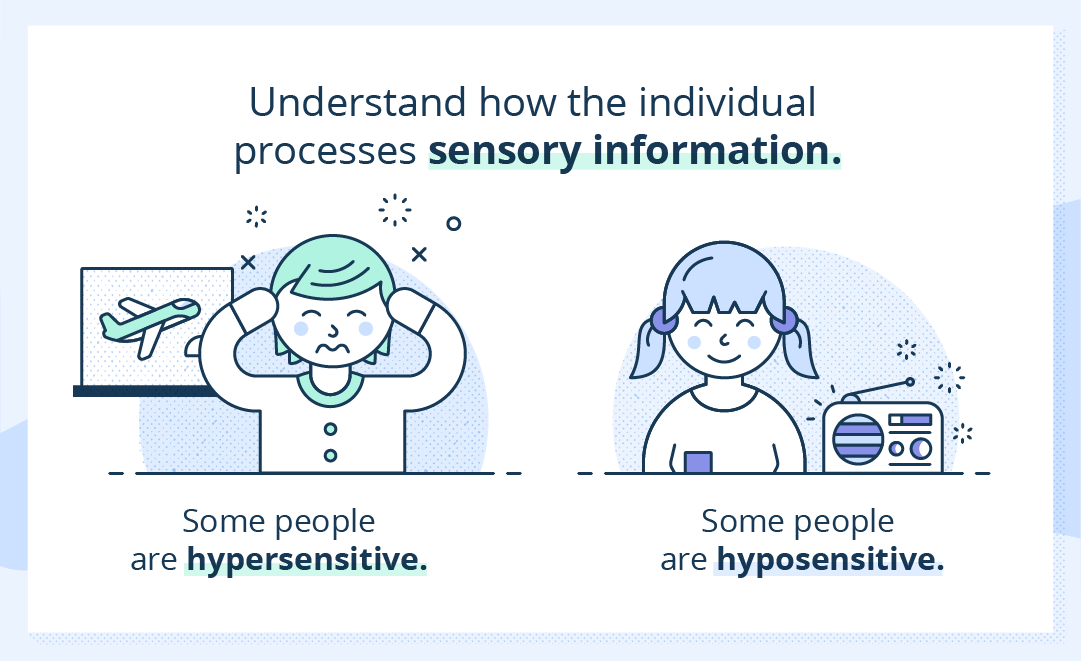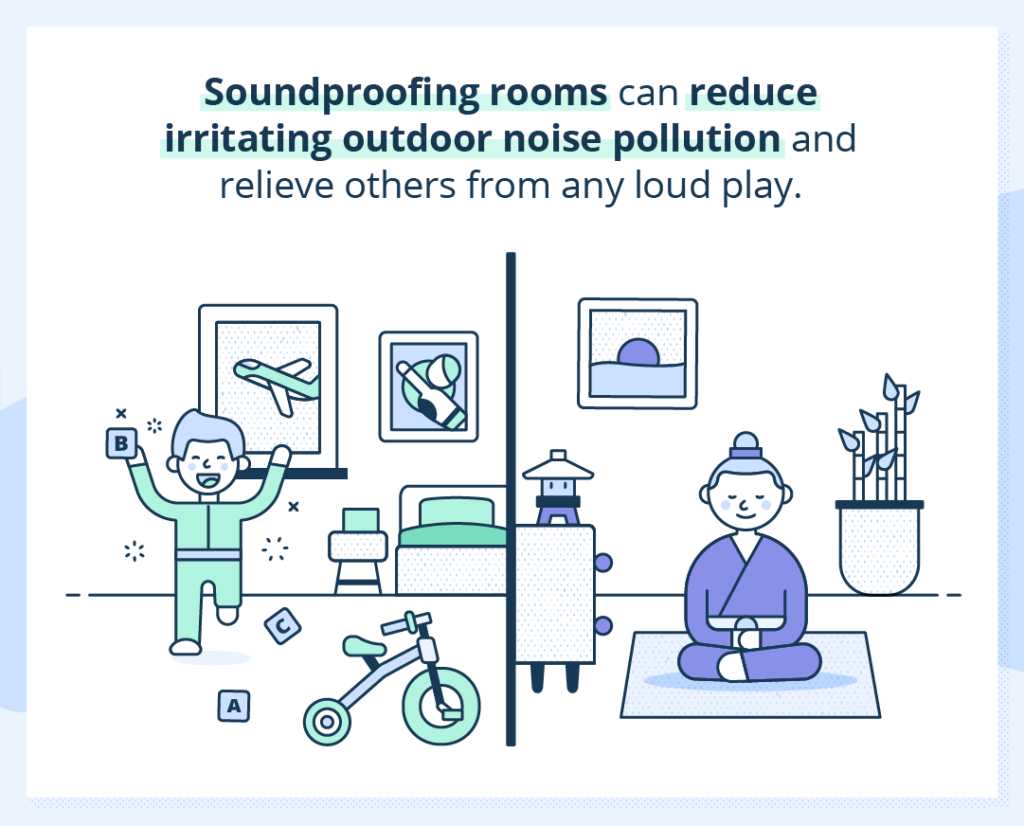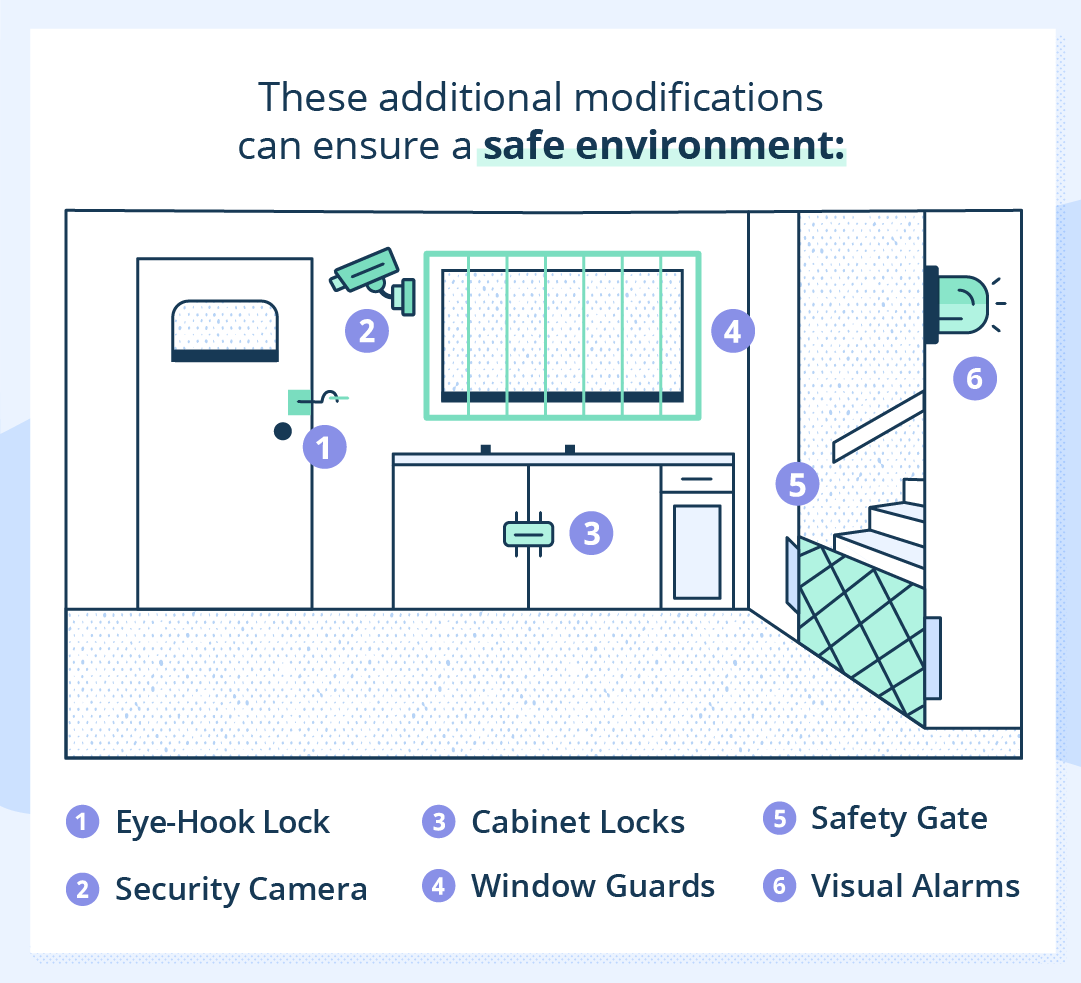Autism Spectrum Disorder (ASD) impacts the normal development of the brain and can cause significant social, behavioral, and communication challenges. Approximately one in 59 children in the U.S. are diagnosed with ASD, which is usually detected around age two. Early diagnosis and intervention has been shown to greatly improve outcomes for individuals with autism. Providing the right support for people with autism at all stages of life can significantly enhance quality of life for both individuals with autism and their families.
In order to best support people with autism, there are a number of home modifications families can make. This guide covers reasons why you should consider modifying your home, what to evaluate before making any changes to your home, and potential modifications you can make.
Table of Contents
Why You Should Modify Your Home

Creating an environment that improves quality of life, is safe, and promotes independence is critical. Although home modifications can be expensive, it is important to keep in mind that creating an ideal environment for people with autism can ultimately save families money as the cost of out-of-home care can be high.
To Improve Quality of Life
It is worth investing in modifications that are going to significantly improve the quality of life of the person with autism as well as the lives of other family members. Creating a supportive, therapeutic environment can greatly improve behavioral problems as it is difficult to address problem behavior in an unsuitable environment. Quality of life is very much dependent on individuals feeling safe and comfortable at home.
To Make Your Home Safer
Making your home as safe as possible for all family members is also an important reason to make modifications. In order to reduce the risk of potential harm, there are a number of structural and organizational changes you can make. These changes can range from very significant, such as removing walls to create an open floor plan in order to improve visibility, to simple modifications like adding a gate.
To Promote Independence
Creating a space that is safe and supportive can also ultimately promote independence. Giving a person the tools they need to be in better control of their own life is extremely beneficial. More independent individuals may be more confident and less reliant on family members and caretakers in the future.
To Reduce Costs
Autism can pose a significant financial burden on families. Half of families report the need to reduce or stop work, which results in lost wages, and a third of families experience financial burdens related to additional health care costs. Creating an ideal environment for the individual with autism can save families money long-term. Family members may be able to more easily continue working, and can potentially avoid expensive out-of-home placement.
What to Consider Before Modifying Your Home

It is important to understand the cost benefit of any changes you may make to your home. Some modifications are extremely costly, for example, removing carpeting and installing hardwood flooring, and may not actually improve the quality of life of any individuals involved. However many modifications, even those that are more costly, are likely worth it if they have a positive impact on the individual with autism or other family members.
Since autism can be experienced very differently from person to person, it is important to understand how the individual with autism interacts with the world around them before making any modifications. Processing sensory information can be a major challenge for people with autism. Someone with autism may be hypersensitive (over-sensitive) or hyposensitive (under-sensitive) to sights, sounds, smells, tastes, touch, balance, and body awareness. Families should evaluate how the individual processes sensory information and make modifications based on their specific needs.
You may want to start by identifying current challenges and noting which of these issues may be related to the home. For example, if the autistic individual is hypersensitive to light and your home as fluorescent lighting, switching to incandescent lights may greatly improve their experience. Once you have done this you can consider making modifications that will improve quality of life with the individual’s unique needs in mind. Involving the individual as much as possible in the process will ultimately help you create the most effective and therapeutic environment. Modifications can be made with the sensory system in mind, to specific rooms, and for additional safety.
Home Modifications for Sensory Systems
When making adjustments to the home keep the individual’s specific sensory sensitivities in mind. Understand whether the individual is hyposensitive or hypersensitive to stimuli such as sights, sounds, and smells. For example, one individual might be very irritated by the noise of hardwood floors, but another individual may be extremely bothered by stains or potential smells from spills on carpet. Knowing the individuals preferences will make it easier to choose beneficial and worthwhile modifications. Depending on the individual and your family you may consider making some of these modifications:
Lights
-
- Choose natural incandescent lights over harsh fluorescent lights.
-
- Choose lights that do not flicker or make buzzing noises, which can be bothersome to over-sensitive individuals.
-
- Consider installing dimmers so that the amount of light in a room can be easily manipulated. You may also want to install blinds so that you can easily control the amount of natural light in a room.
-
- Think about putting anti-glare coatings on windows or hanging blackout curtains to limit outside lighting especially in bedrooms.
-
- Minimize or cover up lights from electronics or other devices.

Floor Plans and Construction Techniques
-
- Consider an open floor-plan. This type of layout makes it easier to supervise and can make for a more organized-looking environment. However, it is important to note that large open spaces can create echos, which can bother individuals who are sensitive to sounds or family members and neighbors if the individual has frequent tantrums.
-
- Create an in-home walking loop to use for pacing to help individuals relieve stress.
-
- Understand whether hardwood flooring or carpeting will work best. Hardwood may be better for some individuals as it is easier to clean, but carpeting is quieter to walk on.
-
- Reduce noise pollution by soundproofing rooms using acoustic panels, adding a layer of drywall, and replacing traditional doors with sound-blocking doors, as sensory-sensitive individuals may be bothered by outside noise pollution. This may also be beneficial for family members and neighbors as sensory-seeking individuals may enjoy making noise. Additionally, some autistic individuals may have more frequent tantrums or meltdowns than others, and family members and neighbors will likely appreciate steps taken to make these events more private.
Home Decor and Organization
-
- Be aware that people with autism often have different responses to colors. Know how an individual responds to colors such as yellow, blue, green, and red.
-
- Keep the home neat and free of clutter so that sensory-sensitive individuals are not overwhelmed, and sensory-seeking are less likely to accidentally bump into anything.
-
- Choose soft, natural colors for walls and decorations and avoid complex patterns. Also, consider limiting wall and other home decor, as clutter can be bothersome and potentially hazardous.
-
- Consider waiting to move into a freshly painted home or room as the smell can be overwhelming.
-
- Remove or raise shelves so that individuals are not tempted to climb on them or do not accidentally bump into them.
-
- Remove furniture with sharp edges that can cause injury if they are accidentally bumped into.
-
- Choose durable over breakable decor and household items. You may want to opt for plastic over glass.
-
- For an individual that is under-sensitive to visual stimulation it may be useful to add visual supports. Putting labels on objects can be useful.
-
- Consider storing trash under the sink to reduce potentially irritating smells.
Room-Specific Modifications
Turn a Bedroom into a Sanctuary Space
We all want to feel comfortable and safe, especially in our own bedrooms. A bedroom for an individual for autism should be a sanctuary space for them. If they are sensitive to light, be sure to invest in blinds and blackout shades in order to control natural light. You may also consider having them weigh in on decisions regarding wall color and decor. This can not only bring them joy, but also help individuals feel more in control of their own lives. If you’re designing for a child with autism, consider these tips from This Old House.
Create a Workspace or Therapy Room
A therapy room is a great place to add stimulation boosting tools for individuals that are sensory-seeking. You can add items such as a small ball pit, big pillows, swing, trampoline or tunnel. This space can be used for someone to work through intense movements, as well as a place to practice independent living. Depending on the individual’s preference and the size of your home, a bedroom can also double as a therapy room.

Create a Display Wall
Designate a room or wall for displaying the individual’s achievements. This is a great way to boost their confidence and demonstrate how proud you are of their accomplishments. You can display artwork, report cards, awards, and other items that recognize their hard word.
Make the Kitchen Safe
It is important to make your kitchen, which traditionally has many dangerous items such as knives and glassware, as safe as possible.You may want to choose plastic over glassware as it is more durable and presents less of an injury risk. Since many people with autism have a fascination with water because of how stimulating it can be for the senses, it may also be important to hide faucets (via a small vanity or other technique) and lock cabinets around sink appliances. Additionally, you may consider installing scald-prevention devices to prevent burns from very hot water.
Make the Bathroom Safe
It is important to take the necessary precautions to make the bathroom safe as well. As mentioned, some people with autism find water captivating. It is important to install flood and scald prevention devices as well as no-slip matts in all bathrooms. You may also consider putting a lock on the toilet to keep out curious hands.
Additional Modifications for Safety

-
- Install gates to keep children with autism from wandering around the home unsupervised.
-
- Use safety locks on cabinets, especially those containing potentially harmful items such as cleaning products.
-
- You may consider installing and keeping up window guards to prevent falls or bolting.
-
- Nearly half of individuals with autism wander or bolt from safety so it is likely worth investing in at least some assistive smart home technology. Adding security cameras and alarms that sound when doors or windows are opened can help you with monitoring the individual.
-
- You can also place hook and eye locks on doors above the individual’s reach in order to prevent wandering.
-
- Since some individuals are under-sensitive to noise, you may consider adding visual alarms for fire safety.
-
- Be sure to take extra precautions with pools. It is important to note that drowning is a leading cause of accidental death among individuals with autism.
Additional Resources
Landlords who are planning to renovate may want to consider making modifications or designing homes in a way that can benefit people with ASD. They will want to ensure that rental applications ask prospective tenants if they have any special needs. If you know ahead of time that someone with autism is moving into your property, you may consider making additional modifications in order to improve the quality of life of both the tenants and neighbors in close proximity, as well as being accommodating to the tenant when and if they wish to make their own home modifications.
Landlords can download a free rental application from TurboTenant, which includes a question about special needs and requirements, to ensure that they are prepared to accommodate individuals with autism.
